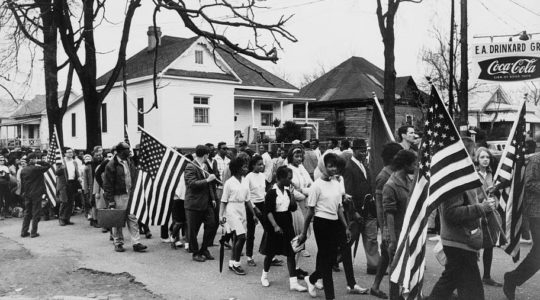A major battle has been won in the fight for restitution of prime property in Berlin to its Jewish heirs. The Karstadt-Quelle company is dropping its suit to retain properties in former East Berlin that once belonged to the Wertheim family, which ran one of the biggest department store chains in pre-Hitler Germany.
The decision, confirmed to JTA by the company on Dec. 1, was greeted with enthusiasm by lawyers for the family and by the Claims Conference, which filed and fought the cases. Both hoped this signaled Karstadt’s readiness to face what many saw as inevitable — restitution of the properties, or payment of their value.
“We are extremely pleased,” Gideon Taylor, the Claims Conference’s executive vice president, told JTA. “There is no question this is a tremendous breakthrough.”
Taylor said several other cases were pending against Karstadt, which has 92,000 employees and had more than $15 billion in sales last year.
“This case is really about history — it is about making sure that the story is told the way it really happened,” he said.
“You’re talking about prime real estate, right in the center of Berlin. At one point it was destroyed, it was rubble,” Taylor said. “And today it is one of the most valuable pieces of real estate in the country.”
The reserved celebration came after Joerg Howe, spokesperson for Karstadt, said in the German media that that the company would “withdraw our suit” to retain title to four parcels of real estate where Wertheim department stores were located before World War II. JTA has since confirmed that this action by the company is taking place.
“We take every small victory as it comes,” said Gary Osen, a lawyer for the Wertheim family in New Jersey, “but there still is a long way to go.”
Now that Karstadt has dropped the suit, the property or its value should be transferred to the Claims Conference as the successor organization. In such cases, about 80 percent of the proceeds usually go to the heirs.
The Claims Conference uses the rest for programs to help needy Holocaust survivors and to meet its administrative costs.
The suit, which was to be heard in Berlin’s administrative court Dec. 9, was a complaint by Karstadt-Quelle against the reassignation of a key property to Wertheim by a state Restitution Authority. But the prognosis for Karstadt was not good: Last March, in a similar case, the court ruled that Karstadt-Quelle had failed to establish itself as the legal successor of another parcel, and Karstadt’s appeal against that ruling failed in the German High Court in Leipzig in October.
Howe told the DPA news service a withdrawal from the latest suit would not cause the company any financial damage, because the property in question was not actually owned by Karstadt.
“Our claims simply were not recognized,” he said.
He added that the company would not give up its legal claims over another parcel known as the Lenne-Triangle, a parcel near the former Berlin Wall that Karstadt sold to Otto Beisheim for some $175 million.
Beisheim reportedly invested nearly a half-billion dollars on the site, building the Ritz Carlton Hotel.
Karstadt-Quelle already has fought against several reassignations of property. Matthias Druba, an attorney for the Wertheims in Berlin, told DPA that there are at least three similar cases open.
In all, there were seven prime Berlin properties in question, worth about $590 million today. In October and November, American courts refused to hear suits by the Wertheim family related to the properties, but German courts have found for the Claims Conference.
In the latest development, Karstadt must have “realized that there was no possibility of them succeeding,” Taylor said, “and that the legal victories we had up to now had set up the legal situation such that it was going to be a clear victory for the Claims Conference.”
JTA has documented Jewish history in real-time for over a century. Keep our journalism strong by joining us in supporting independent, award-winning reporting.
The Archive of the Jewish Telegraphic Agency includes articles published from 1923 to 2008. Archive stories reflect the journalistic standards and practices of the time they were published.



